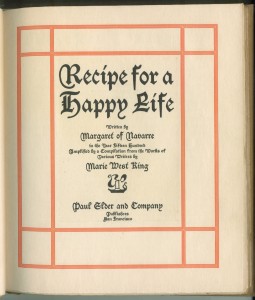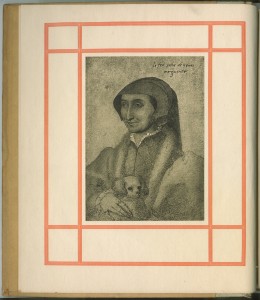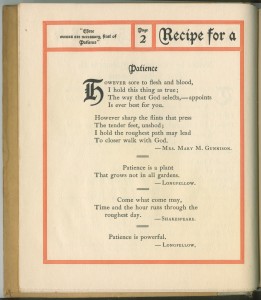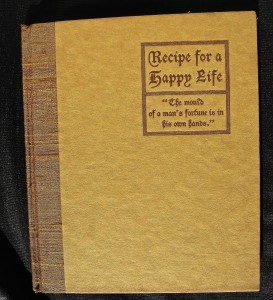
Written by Margaret of Navarre in the year 1500:
Three ounces are necessary, first of Patience, then of Repose & Peace; of Conscience a pound entire is needful; of Pastimes of all sorts, too, should be gathered as much as the hand can hold; Of Pleasant Memory & of Hope three good drachms there must be at least. But they should moistened be with a liquor made from True Pleasures which rejoice the heart. Then of Love’s Magic Drops, a few—but use them sparingly, for they may bring a flame which naught but tears can drown. Grind the whole and mix therewith of Merriment, an ounce to even. Yet this may not bring happiness except in your Orisons you lift your voice to Him who holds the gift of health.

These few words on page 1 of Recipe For a Happy Life (1911) are in fact the only words by Margaret in the entire book. The rest of the text consists of quotations compiled by Marie West King along the themes (italicized above) in Margaret’s recipe.
Marguerite de Navarre (1492-1549), also known as Marguerite of Angoulême, was a French noblewoman, Queen of the small Kingdom of Navarre by her marriage to Henry II of Navarre. Margaret’s brother Francis I was later King of France, and her grandson Henry IV was the first in the long line of Bourbon kings of France.
Margaret became the most influential woman in France during her lifetime when her brother Francis I ascended to the French throne in 1515. Her salon, known as the “New Parnassus,” became famous internationally. She wrote many poems and plays. Her most notable works are a classic collection of short stories, the Heptameron, and a remarkably intense (and very controversial) religious poem, Miroir de l’âme pécheresse (Mirror of the Sinful Soul).

There is evidence that Margaret had some influence in England. A letter to her from English Queen Anne Boleyn survives, and in 1545, twelve-year-old princess Elizabeth (later Elizabeth I) translated Margaret’s Miroir into English and gave it as a gift to her stepmother Catherine Parr (sixth wife of Henry VIII).

Margaret of Navarre is not to be confused with the medieval Margaret of Navarre, Queen of Sicily (ca 1128-1183), a Spanish noblewoman who lived 350 years earlier.
I have been able to find no further information on the compiler, Miss Marie West King. This is her only association with a Paul Elder publication.


